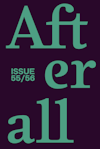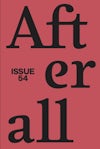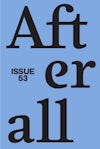
Issue 5
Spring/Summer 2002
Editors: Charles Esche, Mark Lewis, Silke Otto-Knapp.
Founding editors: Charles Esche, Mark Lewis.
Table of contents
Foreword
Contextual Essays
- The Decline of the Circus and the Marching Band Is Permanent and Final – Will Bradley
- A Lecture on Realism – Raymond William
Artists
Pawel Althamer
- Looking Back Without Being Able to See – Martin Prinzhorn
- The Annotated Althamer – Adam Szyczyk
Mary Heilmann
- Love Action: Mary Heilmann and the Joy of Painting – Terry R. Myers
- Images as the Symptoms of Painting: The Antitotalitarianism of Mary Heilmann – Martin Prinzhorn
Barbara Kruger
- Peasant Uprisings in Seventeenth-Century France, Russia and China – Liam Gillick
- Freedom versus Function – Isabelle Graw
Chris Petit
- Detail, Digression, Death: The Movies in Chris Petit’s Film Negative Space – Laura Mulvey
- Anatomies of the Image – Serano Murri
Anri Sala
- Getting Lost Is of the Essence: Anri Sala’s Cinematic Parables – Mark Kremer
- Finding the Words – Soren Grammel
Foreword
Written by Charles Esche & Thomas Lawson
In recent issues, Afterall has developed a consistent interest in the expanded possibilities of art, particularly in relation to the theatre and the different genres of film and television production…
In recent issues, Afterall has developed a consistent interest in the expanded possibilities of art, particularly in relation to the theatre and the different genres of film and television production. While the topic might appear obvious given the marked turn of art towards performance and moving-image media in the 1980s and 90s, we have tried to uncover the underlying motivations for this remarkable expansion in the possibilities for ‘visual art’ in the last decades. Issue 5 maintains this outlook, bringing together five artists that all exploit this permissiveness to manufacture their own rules of engagement with their audiences and the now historic traditions of twentieth-century art. The range of positions amongst the five artists demonstrates the degree of diversity that art can now encompass, while maintaining a notable vestige of the avant-garde idea of privileging experimentation and originality above all else.
To define the edges of this territory of visual art practice is perhaps a useful way to seek some understanding of its breadth, even if those edges are constantly up for challenge and are no longer the edges of shock or outrage that motivated many artists in the last century. In this issue of Afterall, a number of those softer boundaries between practices and areas of knowledge seem to be provoked. At one extreme lies the proscenium arch theatre, to which few outside the established lobby are attracted except as a training ground for film and television. Artists are certainly not about to invade the stage and the impressiveness of ‘live’ experience amongst so many mediated or already theatricalised versions of the everyday is less and less potent, as Will Bradley’s cogent essay points out. Yet much of Pavel Althamer’s work provides one of the most persuasive arguments for the possibility of live theatre in terms of effectively destabilising identities between players and viewers, and forcing a confrontation with our own public and private roles.
Purchase
The publication is available for purchase. If you would like specific articles only, it is also available individually and to be downloaded as PDFs.
Purchase full publication
Buy via University of Chicago Press
Buy via Central Books
Purchase individual articles
Buy via University of Chicago Press




